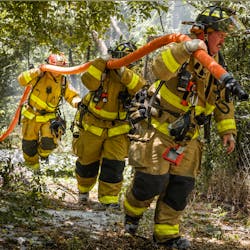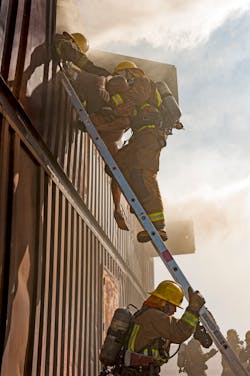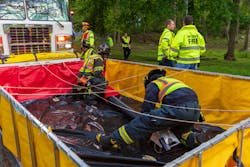Imagine that you’re called to a two-story, single-family dwelling with fire involvement throughout the first floor. Upon arrival, a frantic neighbor meets you in the front yard and tells you that two children are trapped in their bedroom on the second floor.
As you round the A-D corner of the house, you find two children who are yelling from their bedroom window. You determine that the best way to effect a rescue is to have one crew start a fire attack at the front door while a second crew initiates a rescue of the juveniles from the window. You order the two teams into action and tell the youths to close their bedroom door and return to the window. Team 1 deploys a 1¾-inch pre-connect, which lands in a pile on the ground, effectively tying a knot. After they untangle the hose, they pull it to the front door and realize that they pulled the short pre-connect rather than the long line. After they add two lengths to the hoseline, they are ready to apply water and make entry, but they find that the front door is deadbolt locked. One firefighter returns to the engine to retrieve the irons; the other firefighter tries to shoulder the door to break through it but is unsuccessful. After a few minutes of hammering and prying of the door, the door is opened, and water is applied to the fire with a quick knockdown.
Team 2 takes the 24-foot extension ladder to the D-side bedroom window and begins the ladder raise. The tight space that’s between the house and the fence makes it difficult to raise the ladder, but after a struggle Team 2 gets the ladder to the window. Two firefighters climb the ladder to assist the children down. One of the firefighters climbs into the bedroom; the other remains on the ladder. The first child is an 8-year-old boy who is very scared of heights. The firefighters have a difficult time convincing the young boy of the safety after the firefighter who is on the ladder slips—and doesn’t appear comfortable with heights either. After a few minutes of convincing, the first child is helped down the ladder. The second youth, a 3-year-old girl, is next. The firefighter who is in the room has her in his arms and is ready to transfer her to the firefighter who is on the ladder, however the ladder firefighter isn’t comfortable with the task. The two firefighters decide that they will switch places, and the child is safely removed down the ladder.
No firefighter or civilian injuries are reported at the fire. The fire is brought under control, but substantial damage was inflicted on the first floor and to the stairway that leads to the upstairs bedrooms.
The parents of the two youths were on a walk in the neighborhood and returned when they heard sirens and saw smoke that was emanating from the direction of their house. They arrived at the house as their children were being brought down the ladder. They were very thankful for the heroic “quick action” of the firefighters.
This scenario isn’t far from reality on some fire scenes across the United States and around the world: Some scenes don’t go smoothly. Hopefully, an officers’ meeting follows, and at the meeting, the decision is made that more training on “routine” fire scenes must be completed. The chief assigns you, the training officer, to come up with training to simulate this scenario and the tasks that were faced during the incident. Unfortunately, you don’t have a training tower or drill ground to simulate this scenario. What do you do? How do you simulate effective: pre-connect deployment; estimating hose length; a second-floor rescue; a locked-door forcible entry; and other common fireground tasks? How do you utilize your existing fire station and community resources to get a more realistic training experience for your firefighters?
Estimating hose length
Good community relations are the foundation of a successful fire department. With that foundation, you can take advantage of various community buildings and locations for training. One of the best ways to get firefighters better at estimating hose length and deployment of pre-connects is to practice it repeatedly, in different locations with different types of buildings. Find a large commercial building that has an open parking lot (think school facility, because it has few vehicles after hours) to practice this task. You can pre-measure distances on the parking lot, marking lengths with chalk marks, to identify distances to the building. Then, have firefighters estimate the lengths that are needed.
You can approach this training in two ways. First, have firefighters estimate lengths, then pull rope that’s marked at lengths, so the firefighters don’t need to reload hosebeds so often. Second, after the firefighters get a better handle on estimating length, have them pull the actual pre-connects from engines that they use for response. Then, reload. As a result, you accomplish length estimation, hose load deployment procedures and reloading training, all of which are important to efficient and effective scene performance.
Be sure to use different locations with varying obstacles in the path to the access point for hose deployment. If firefighters continually train on the same location with a direct shot at the front door of the fire structure, they will have difficulty when estimating lengths around hedge rows, vehicles that are in the driveway, locations other than the front door and other variants that always exist on the fireground.
Apparatus operator training
Another use for large parking areas is for driving courses and apparatus operator training. Using a parking lot or large industrial open area that’s free of obstructions is a great way to have a pre-designated driving course for all sizes of your apparatus. With permission from the owner of the property, you can paint marks on the parking lot where cones are placed to create your driving course. (A simple small dot of paint on the ground leads to much faster setup of the course and offers exact consistency between trainings.) Use different colors for different size apparatus.
This same large area can be used for flowing water and teaching apparatus operations. (The preferred surface for operator training is pavement or concrete, so water that flows and excessively discharges from drains—while training, it happens—doesn’t create holes in a gravel driveway.) An even better area for this training is a large, paved lot that has a water supply/hydrant, so you can practice hydrant operations at the same time.
Combine all of these trainings to make a scenario of navigating a difficult driving course, positioning apparatus at a building, deploying the correct length of hoseline, apparatus operator work and hydrant or drafting operations. Such training will keep many firefighters who possess differing levels of training engaged and active all along.
A way to train on second-floor window operations without the advantage of an acquired structure, a drill tower or a community building is to buy or build a window prop.
One way to use the prop, if possible, is to place it on top of the fire station flat roof. Another is to build the prop to anchor to a peaked roof. Another is to use the prop on a mezzanine that’s inside of the station, if your firehouse has one, or on a commercial mezzanine in a community partner’s building.
Utilize local building contractors and carpenters to help to build the prop and to ensure that proper strength and safety features exist, particularly when elevating the prop onto the roof of the fire station. This might sound as if it will cause damage to the building or look ugly, but with the proper construction techniques, both of those concerns can be addressed.
Additionally, the prop can be used on a small, elevated platform, such as a stack of pallets that you get for free from a store, or at the edge of a loading dock. Of course, these circumstances aren’t the same height as a second floor, but they do allow ladder work, firefighter entry and exit through a window, and removal of victims through a window onto a ladder.
Possibly the best way to train on second-floor operations is to utilize a house that’s being renovated, newly constructed or replaced, even if you only get to practice one night. This provides the best realism for ladder training on actual windows.
Forcible entry
Forcible entry props come in various shapes and sizes—and price tags! Another opportunity for your community to support its fire department is to find a way to use a metalsmith, welding company or fabricator to build in a forcible entry prop to one of the doorways of the fire station. Choose a doorway in the firehouse that might be less used or out of the way so that the prop can be used for training any time. The door part of the prop can be removable and replaced with a locking door if a storage room or other room must be secured when the prop isn’t in use.
A hallway that connects station sections also can be a good place to build a force prop at the station—preferably in the apparatus bays, because the walls and floors of the bays might be more durable than elsewhere in the firehouse. Here, again, the door should be fully removable so that the hallway is functional when the prop isn’t in use.
If you’re able to locate the forcible entry prop near an exterior door (or an actual exterior door in some way to keep the station secure when not in use), the prop can be incorporated into larger fire attack scenarios. Use that door as your target for interior crews—after estimating hose length and deploying pre-connects or hoselines to the fire—to “enter a structure,” and require interior crew members force the door. These types of combination drills increase member participation, enthusiasm for training and effectiveness of drill time.
Using your department vehicles in strange ways also can substitute for a training tower or drill ground. This type of training genuinely can test a firefighter’s ability to think through a solution in a unique situation, all while in the fire station using equipment on the apparatus. For example, place a victim (dream up a scenario that exists in your jurisdiction) on top of the hosebed on your engine or on top of your water tender and train on extricating a victim from elevated platforms. For instance, you’re faced with extricating an unconscious patient from a rock ledge that’s 10 feet above the ground. You can utilize a ladder system, a tripod lowering system or another system that your jurisdiction possesses. This drill very easily can incorporate EMS competencies as well as patient packaging techniques for vertical and horizontal lowering.
If protection of the apparatus from scratches is needed, place a large salvage cover or tarp over the “operational area.”
Also, think about ways to use department vehicles for extrication and vehicle stabilization/lifting training: lift brush trucks, command vehicles and even parts of engines with airbags and blocks. Placing patients in strange and awkward orientations inside of apparatus cabs, command vehicles and other equipment can be great patient-extrication trainings without using hydraulic tools to open a vehicle—if your department even has extrication equipment. Of course, caution and care must be taken to not damage vehicles and, even more importantly, when placing live “victims” in and around the vehicles. Don’t place victims in any location or situation that could cause them injury if a mistake is made during training. For example, no live victims or rescuers ever should be under a vehicle when practicing lifting techniques with air bags. It’s important to create realistic situations but not at the expense of a serious injury or death.
In your own way
Training grounds, drill towers and commercially available props are great investments and provide amazing solutions to fire service training. However, there certainly can be times when they aren’t feasible or realistic for your department’s situation. Use the assets that you have to think of new and creative ways to provide training opportunities to your department.
Agency members who have special skills and occupations and community partners can provide great assistance when faced with a need to be creative. Don’t be afraid to try new ways to train and to get out of the fire station and into the community to ask community partners for help and permission to train on their properties. With a little bit of ingenuity, community relations and perseverance, your training program can be as good, if not better, than one that has all of the bells and whistles of a large training facility or drill tower.
Good friends and mentors of mine, Vickie Pritchett and Shane Ray of the National Fire Sprinkler Association, say, “Thinking firefighters do it different!” Be a thinking firefighter and instructor. Do it different.
About the Author

Devon Wells
Devon Wells is the past president of the International Society of Fire Service Instructors (ISFSI) and the emergency response program manager for Tactical Aeronautics in Hood River, OR. He is the former fire chief of Hood River, OR, Fire & EMS and is a 30-year veteran of the fire service. Wells currently volunteers for the Wy'East Fire District in Oregon. He presents nationally on safety, leadership, organizational philosophy and rural fire officer topics. Wells is on the NFPA 1700 committee on Fundamentals of Fire Control within a Structure Utilizing Fire Dynamics. He manages the Rural Fire Officer Facebook page.


